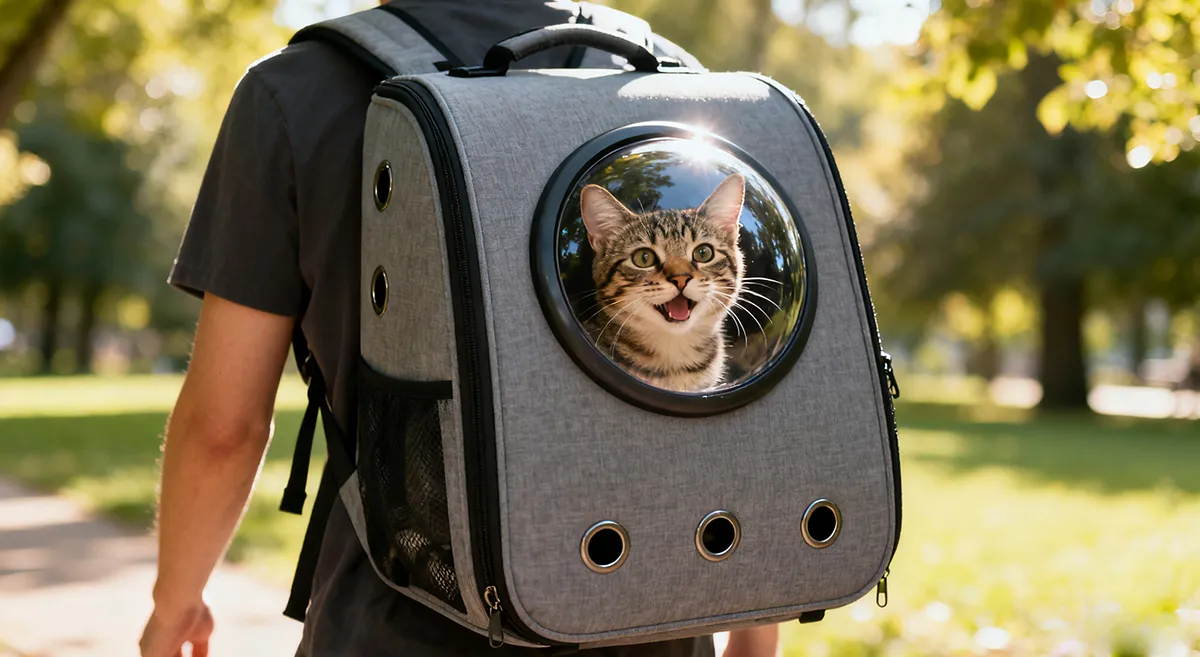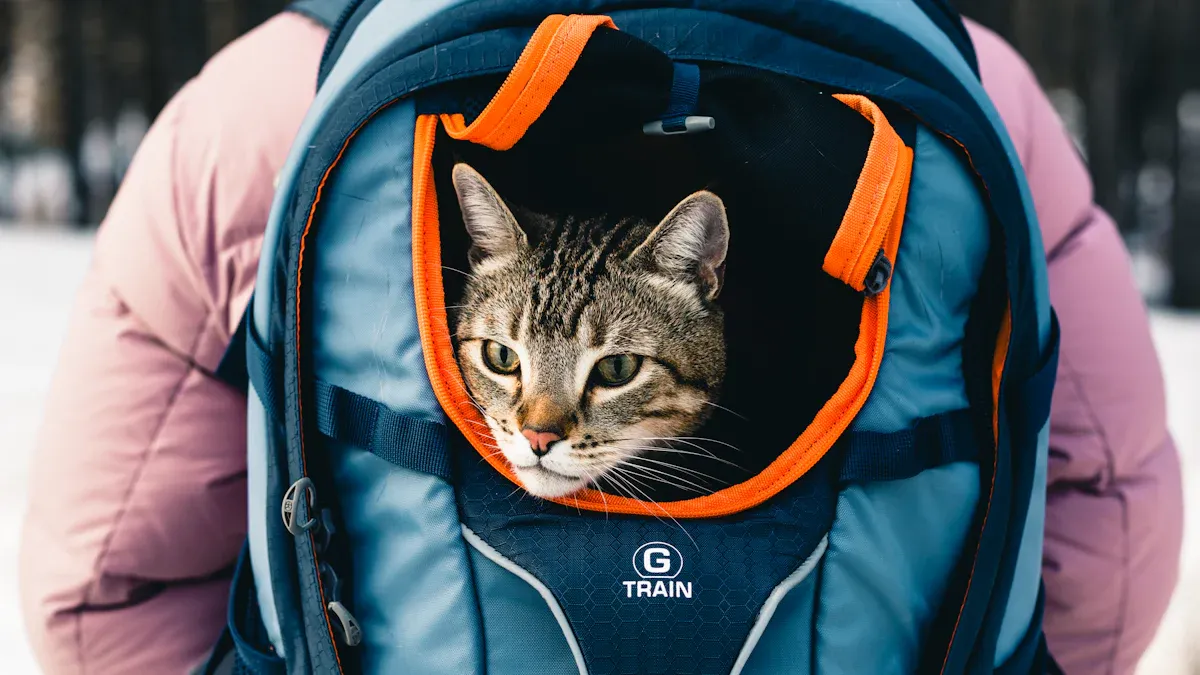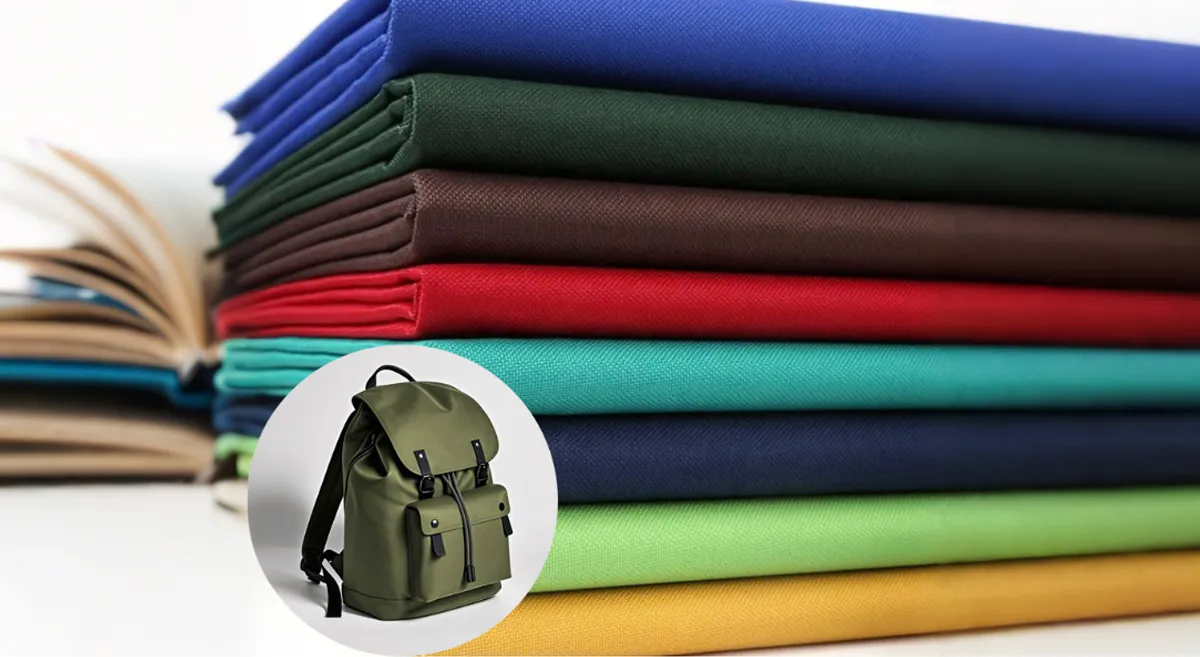
Are cat backpacks safe for your pet? Many cat owners use backpacks for travel, hiking, and daily commuting. Take a look at how people use them:
| Purpose of Use | Percentage of Cat Owners |
|---|---|
| Pet Travel | 49% |
| Hiking and Outdoor | 34% |
| Daily Commuting | 27% |
| Commuting in the Middle East and Africa | 33% |

You need to pick the right backpack and use it with care. Veterinarians say you should make sure the backpack gives your cat space to hide, fits your cat’s size, and has good airflow. Add a blanket or treats for comfort. Use it for short trips. Think about your cat’s personality and what makes them feel safe.
Key Takeaways
- Pick a cat backpack that has lots of air holes. This helps your cat stay cool and comfy.
- Make sure the backpack is the right size for your cat. Your cat should have space to move and lie down.
- Look for strong zippers or locks so your cat cannot get out.
- Let your cat get used to the backpack slowly. Give them time to sniff and explore it.
- Do not keep your cat in the backpack for more than 30 to 60 minutes. This helps stop stress and keeps your cat happy.
- Give your cat treats and say nice words when they use the backpack. This helps your cat feel good about it.
- Watch your cat for signs of stress or if they seem upset. Take breaks if your cat needs them.
- Clean the backpack often. This keeps it safe and healthy for your cat.
Are Cat Backpacks Safe?
You might wonder, are cat backpacks safe for your furry friend? Many pet owners ask this question before buying a new backpack. Experts say that cat backpacks can be a safe and reliable way to transport your cat, but you need to pay close attention to design and how you use them. When you choose a sturdy backpack that fits your cat’s needs, you give your pet a secure space for travel and adventure. Cat backpack carriers offer security and can even provide mental and physical enrichment during trips.
Safety Factors
Ventilation
Good ventilation is one of the most important features in any cat backpack. Your cat needs fresh air at all times. Look for a backpack with plenty of air holes or mesh panels. This helps prevent overheating and keeps your cat comfortable. If you use a bubble-style backpack, make sure it has enough airflow. Without proper ventilation, your cat may feel trapped or anxious.
Space and Movement
Your cat should have enough room to turn around and lie down inside the backpack. If the space is too tight, your cat may feel stressed or uncomfortable. Choose a backpack that matches your cat’s size. Add a familiar blanket or treats to help your cat relax. Cat backpack carriers that are not fully transparent can give your cat a sense of security and privacy.
Secure Closures
A secure backpack keeps your cat safe during travel. Check that all zippers, latches, and doors close tightly. Your cat should not be able to push open the backpack or escape. Some backpacks have extra safety locks or clips. These features help prevent accidents and keep your cat secure on the go.
Common Safety Mistakes
Many people make mistakes when using cat backpacks. Here are some things you should avoid:
- Forcing your cat into the backpack without letting them get used to it. This can cause anxiety and panic.
- Picking a backpack with poor ventilation. Your cat may feel hot and uncomfortable.
- Using a backpack that is unstable or flimsy. Your cat could get injured if the backpack tips over or collapses.
- Forgetting to check the secure closures. If the backpack opens by accident, your cat might escape.
Tip: Always let your cat explore the backpack at home before you travel. This helps your cat feel safe and secure.
Are cat backpacks safe for every cat? The answer depends on your cat’s personality and how you use the backpack. Bubble backpacks are safe for short trips if they have good ventilation. They are not cruel when used correctly and are similar to standard carriers. You should always follow usage guidelines and watch your cat for signs of stress. Cat backpacks can be a great choice for many pets, but you need to make safety your top priority.
Types of Cat Backpacks

When you shop for cat backpacks, you will see many styles. Each type has its own features and works best for different cats and situations. Let’s look at the main types you can choose from.
| Backpack Model | Features | Design Type |
|---|---|---|
| The Fat Cat | Mesh pockets on each side, soft body, top opening with strap | Top open, pockets |
| The Navigator | Most pockets, front and top mesh panels, water reservoir | Top open, pockets |
| The Jackson Galaxy | Mesh pockets on each side, top opening for head out | Top open, pockets |
Bubble Cat Backpacks
Bubble cat backpacks stand out because of their clear, round window. This window lets your cat peek outside and watch the world. Many people like these backpacks for their fun look and the way they let cats see new places.
Pros and Cons
Here are some things to think about if you want a bubble backpack:
- You give your cat a safe way to travel if you use the backpack the right way.
- Bubble cat backpacks work well for short trips, as long as they have good airflow and enough space for your cat.
- Some cats may not like the bubble window or may feel trapped if the backpack is too small.
- If you do not watch your cat, it could damage the backpack or even escape.
Tip: Always check the ventilation holes before you use a bubble backpack. Your cat needs fresh air to stay calm and happy.
Mesh Cat Backpacks
Mesh cat backpacks use strong mesh panels on the sides or all around. These panels let air flow in and out, which keeps your cat cool. Mesh also helps your cat see what is going on outside.
Visibility and Airflow
- Some mesh cat backpacks, like the Petstar Voyager, have three sides made of mesh. This design gives your cat lots of fresh air and helps them stay comfortable.
- Others, like the PETSFIT Pet Carrier Backpack, have mesh windows on all four sides. Your cat can look out and you can check on your cat easily.
Mesh cat backpacks work well for cats that like to see their surroundings. They also help if you worry about your cat getting too hot.
Expandable Cat Backpacks
Expandable cat backpacks give your cat extra space when you stop for a break. You can unzip part of the backpack to make a bigger area for your cat to rest or play. This type is great for longer trips or for cats that need more room.
| Feature | Description |
|---|---|
| Safety First | Made from scratch-resistant, non-toxic Oxford cloth with self-locking zippers and safety rope. |
| Product Size | Expanded size gives your cat more space to relax and reduces stress. |
| Super Breathable & Openings | Four mesh windows let air flow and make it easy to interact with your cat. |
| Shock Absorption & Load Reduction | Honeycomb mesh cushion keeps your cat comfortable during travel. |
| Ergonomic Design | Adjustable straps help you carry the backpack without hurting your shoulders. |
| More Intimate Design | Dust-proof cloth, side pockets for treats, and a reversible cushion for comfort in any season. |
Expandable cat backpacks work best for longer trips or for cats that get anxious in small spaces. You can give your cat a break and let them stretch out.
Note: Choose the type of cat backpack that matches your cat’s personality and your travel plans. Some cats like to see everything, while others feel safer with less exposure.
Potential Risks and How to Avoid Them
Overheating
Overheating is one of the biggest risks when you use a cat backpack. Your cat can get too hot inside, especially on warm days or during long trips. You need to watch for signs like heavy breathing, drooling, or your cat acting tired. If you see these signs, stop right away and let your cat cool down.
You can prevent overheating by following these steps:
- Pick a backpack with good ventilation. Mesh panels or air holes help fresh air move in and out.
- Place a cooling mat or pad at the bottom of the backpack. This keeps your cat comfortable.
- Take breaks often. Let your cat out in a safe spot to rest and cool off.
- Try a backpack with a dual ventilation system for extra airflow.
- Watch your cat’s behavior. If your cat seems tired or stressed, take a break.
Tip: Never leave your cat in a backpack in direct sunlight or a hot car. Even a few minutes can be dangerous.
Escaping
Some cats are escape artists. They may claw, bite, or push at the backpack until they find a way out. If your cat escapes, it can run away and get lost or hurt. This is a real risk, so you need to make sure your backpack is secure.
Here’s how you can stop your cat from escaping:
- Check all zippers, latches, and doors before every trip. Make sure they close tightly.
- Choose a backpack with safety locks or clips.
- Watch your cat while you travel. If your cat scratches or bites at the fabric, stop and check for damage.
- Never leave your cat alone in the backpack.
Some cats may not like being in a backpack at all. They might try to rip the fabric or force their way out. If your cat acts this way, try a different carrier or talk to your vet for advice.
Discomfort or Injury
A cat can feel discomfort or even get injured if the backpack does not fit well or if you use it the wrong way. You need to watch for signs that your cat is not comfortable.
Look for these signs after using a backpack:
- Your cat hides more than usual.
- Your cat makes loud or distressed sounds.
- Your cat has trouble breathing.
- You notice limping or swelling.
- Your cat stops doing normal activities.
To keep your cat safe, always pick a backpack that matches your cat’s size. Add soft padding inside for comfort. Never force your cat into the backpack. Let your cat get used to it slowly at home.
Note: If you see any signs of discomfort or injury, stop using the backpack and call your vet.
By knowing these risks and how to avoid them, you can help your cat stay safe and happy during every adventure.
Stress and Anxiety
Stress and anxiety can affect your cat when you introduce a new backpack. Some cats feel nervous about new things, especially if they have never traveled before. You might notice your cat hiding, meowing loudly, or refusing to go near the backpack. These signs show your cat feels unsure or scared.
You can help your cat feel safe and calm by making the backpack a positive part of its routine. Start by placing the backpack in a quiet room where your cat likes to relax. Let your cat sniff and explore the backpack at its own pace. Do not force your cat inside. Instead, put a soft blanket or a favorite toy in the backpack. This helps your cat connect the backpack with comfort and safety.
Try these steps to reduce stress and anxiety:
- Rub a cloth over your cat to collect its scent, then place the cloth inside the backpack. This makes the backpack smell familiar.
- Use synthetic pheromones in the backpack to help your cat feel calm.
- Prepare a quiet space with your cat’s favorite items, food, and a hiding spot. This gives your cat a safe place to retreat after trying the backpack.
- Allow your cat to explore the backpack and the room without rushing. Let your cat decide when to go in or out.
- Keep a regular schedule for feeding and playtime. Cats love routine, and this helps them feel secure when you introduce new things.
Tip: Play with your cat before and after using the backpack. Play and exercise help lower anxiety and make your cat feel happy.
You can also follow a simple plan to help your cat adjust:
- Set up a quiet room with everything your cat needs before you bring out the backpack.
- Let your cat explore the room and return to its carrier or backpack whenever it wants.
- Slowly open up more areas for your cat once it seems relaxed and comfortable.
Every cat reacts differently to a backpack. Some cats need more time to adjust. Watch your cat’s body language and listen for signs of stress. If your cat seems upset, take a break and try again later. With patience and care, you can help your cat feel safe and even enjoy the backpack experience.
Do Cats Enjoy Cat Backpacks?
You might wonder if your cat actually likes riding in a backpack. The answer depends on your cat’s unique personality and how you introduce the backpack. Some cats love exploring new places, while others prefer to stay home. Paying attention to your cat’s behavior helps you decide if a backpack is a good fit.
Cat Behavior and Preferences
Every cat has its own likes and dislikes. Some cats feel curious and excited when they see a new backpack. Others may act shy or nervous. You know your cat best. Watch how your cat reacts when you bring out the backpack. Does your cat sniff it, climb inside, or walk away? These actions tell you a lot about your cat’s feelings.
If your cat enjoys new experiences, a backpack can become a fun way to travel together. Try placing treats or a favorite toy inside the backpack. This helps your cat build a positive connection. Let your cat explore at its own pace. Never rush the process.
Signs of Stress
Cats show stress in many ways. You need to watch for these signs when using a backpack:
- Flattened ears or a tucked tail
- Hiding or refusing to enter the backpack
- Loud meowing or growling
- Rapid breathing or panting
- Scratching or biting at the backpack
Pay close attention to your cat’s body language. Cats often use small signals to show how they feel. If you notice any of these signs, give your cat a break and try again later. Listening to your cat’s sounds and watching its movements can help you prevent a negative experience.
How to Assess Your Cat’s Comfort
You want your cat to feel safe and happy in the backpack. Here are some ways to check your cat’s comfort:
- Make sure the backpack has soft padding and enough space for your cat to stand, turn, and lie down.
- Check for good airflow with mesh panels or vents.
- Use secure closures so your cat feels protected.
- Let your cat explore the backpack at home with treats and gentle encouragement.
- Watch the temperature inside the backpack. Avoid hot or cold conditions.
- Take breaks during long trips to let your cat relax.
Tip: Stay calm and relaxed when you use the backpack. Your cat will pick up on your mood and feel more secure.
If your cat seems comfortable, you will see relaxed body language and maybe even purring. If your cat looks tense or tries to escape, stop and reassess. With patience and care, you can help your cat enjoy the backpack and make travel a positive experience.
Training Your Cat for a Backpack
Getting your cat used to a backpack takes time and patience. You want your cat to feel safe and happy every step of the way. Here’s how you can help your cat become comfortable with a backpack.
Gradual Introduction
Start slow when you introduce a new backpack to your cat. Let your cat explore at its own pace. Follow these steps to make the process smooth:
- Place the backpack open on the floor. Let your cat sniff and check it out.
- Put treats or a favorite toy inside the backpack. This will attract your cat and make it curious.
- Use gentle encouragement. You can use a target, like a stick or your finger, to guide your cat toward the backpack.
- Once your cat steps inside, reward it with a treat or soft praise.
- Close the backpack for just a few seconds, then open it and give your cat another treat.
- Slowly increase the time your cat spends inside with the backpack closed.
- Pick up the backpack for a few seconds while your cat is inside. Give more treats and praise.
- Walk around the house with your cat in the backpack for short periods.
- Gradually make these sessions longer.
- When your cat seems relaxed, try a short trip outside.
Tip: Always let your cat set the pace. If your cat seems scared, take a break and try again later.
Positive Reinforcement
Positive reinforcement helps your cat feel good about the backpack. You want your cat to think of the backpack as a fun and safe place. Here are some ways to use positive reinforcement:
- Place treats inside the backpack to encourage your cat to go in.
- Praise your cat with a happy voice when it explores or enters the backpack.
- Give your cat a treat every time it hops in on its own.
- Use your cat’s favorite toy to make the backpack more inviting.
- Say things like “Good job!” or use your cat’s name to show you are proud.
Remember: Cats learn best when you reward good behavior right away. Keep treats handy and celebrate small wins.
Practice at Home
Practice makes perfect. Before you take your cat on a real adventure, help it get used to the backpack at home. Try these steps:
- Leave the backpack open near your cat’s favorite spots.
- Put toys and treats inside so your cat wants to explore.
- Feed your cat in the backpack to build a positive link.
- Treat the backpack like a toy, not just a carrier.
- Start with short, fun trips around the house or yard. Avoid stressful places like the vet at first.
Note: The more your cat practices, the more confident it will feel. Keep sessions short and positive.
With patience and practice, your cat can learn to love its backpack. You will both enjoy safe and happy adventures together.
Best Cat Backpacks: Features to Look For
Choosing the right backpack for your cat can make every trip safer and more enjoyable. You want your cat to feel secure, comfortable, and happy. Let’s look at the most important features you should check before you buy.
Safety Checklist
When you shop for cat backpacks, always look for these safety and comfort features:
- Sturdy Build: Pick a backpack made from strong materials. This keeps your cat safe if you bump into something or if your cat moves around a lot.
- Adequate Ventilation: Make sure the backpack has plenty of mesh panels or air holes. Good ventilation helps your cat breathe easily and stay cool.
- Secure Fastenings: Check that all zippers, latches, and doors close tightly. Safety locks or clips add extra protection.
- Comfortable Padding: Soft padding inside the backpack keeps your cat cozy and protects them from bumps.
- Harness & Leash Clip: A built-in harness and leash clip keeps your cat secure but still lets them move a little.
- Collar with ID Tag: Always use a collar with an ID tag in case your cat gets lost.
Safety is a top priority. Made with strong materials and safe zippers, they keep your pet secure. The leash clips also help pet owners feel better, making sure your cat stays safely attached during short trips outside.
Here’s a quick checklist you can use when picking out cat backpacks:
| Feature | Why It Matters |
|---|---|
| Sturdy Build | Protects your cat from bumps and rough handling |
| Ventilation | Keeps air flowing and prevents overheating |
| Secure Fastenings | Stops your cat from escaping |
| Comfortable Padding | Makes travel soft and cozy for your cat |
| Harness & Leash Clip | Adds extra security |
| Collar with ID Tag | Helps find your cat if they get lost |
Sizing and Customization
Getting the right size backpack is just as important as picking the right features. If the backpack is too small, your cat will feel cramped. If it’s too big, your cat might slide around and feel unsafe. Always measure your cat before you buy.
- Choose a backpack that matches your cat’s size and weight.
- Look for padded shoulder straps and a breathable back panel. These features make it easier for you to carry the backpack and keep your cat comfortable.
- Pick a backpack with adjustable straps, like chest or waist straps. These help spread the weight and keep the backpack steady.
- Some cat backpacks offer extra pockets or removable pads. These let you customize the backpack for your cat’s needs.
- Weight distribution features help you carry your cat for longer without hurting your shoulders.
A well-fitted backpack keeps your cat safe and happy. You can even find cat backpacks with fun colors or patterns to match your style.
Tip: Always check the backpack’s weight limit and make sure your cat fits comfortably inside before you travel.
With the right backpack, you and your cat can enjoy every adventure together.
Responsible Use of Cat Backpacks
Monitoring Your Cat
You want your cat to feel safe and happy every time you use a backpack. Start by letting your cat explore the backpack on its own. Leave it open and accessible in a familiar spot. Place toys inside to make the backpack seem fun, and use treats to create a positive experience. Keep the backpack near your cat’s favorite toys so it feels like part of their play area. Begin with short trips to help your cat adjust and enjoy the adventure.
Tip: Watch your cat’s body language. If your cat seems nervous or tries to hide, give it more time to get comfortable.
Trip Duration
Short trips work best for most cats in cat backpacks. Animal experts recommend keeping your cat inside the backpack for only 30 minutes to an hour. Longer trips can make your cat feel stressed or uncomfortable. Always give your cat breaks, let it out to stretch, and offer water. If you notice your cat getting restless or anxious, stop and let it relax outside the backpack.
- Cats should not remain in a backpack for extended periods.
- Limit trips to short durations of around 30 minutes to an hour.
- Make sure your cat gets breaks, water, and time outside the backpack.
Cleaning and Maintenance
Keeping your backpack clean helps your cat stay healthy. After each trip, shake out loose fur and debris. Use a lint roller or vacuum for stubborn hair. Remove any liners and wash them separately. Spot clean stains with mild detergent and warm water. If your backpack is machine washable, use a laundry bag and gentle cycle. Always air dry the backpack in a well-ventilated area.
To disinfect, spray a pet-safe cleaner or a mix of vinegar and water (1:1 ratio) and wipe with a clean cloth. Avoid bleach because it can harm your cat. Clean the backpack after every trip or accident. Store it in a dry place to prevent mold. Check zippers, mesh, and stitching often to keep the backpack safe. Use a washable liner for easy cleaning. If your backpack has a detachable mat, you can clean it thoroughly for your cat’s comfort.
Note: Wipe the surface of your backpack with a damp cloth to remove dust. Rinse well if you use detergent so no residue stays behind.
Responsible use of cat backpacks means you pay attention to your cat’s needs, keep trips short, and maintain a clean, safe carrier. This way, you and your cat can enjoy every journey together.
Conclusion
You want your cat to feel safe and happy every time you use a backpack. Remember to check for sturdy build, good ventilation, and secure fastenings. Cat backpacks work best when you choose the right size and let your cat get comfortable. Always pick the best cat backpacks with features that protect your cat. We are the manufacturer of cat backpacks, offering full customization and OEM/ODM for wholesale—materials, ventilation layouts, anti-escape locks, reinforced frames, window styles (bubble/mesh), padding, colors, and branding. Get factory-direct pricing, fast sampling, and reliable lead times. Contact us for a custom quote and samples—give your cat the safest adventure.
FAQ
Can kittens use cat backpacks?
You can use a cat backpack for kittens if they weigh at least 2 pounds. Make sure the backpack fits well and has soft padding. Always watch your kitten during trips.
How long can my cat stay in a backpack?
Most cats feel comfortable for 30 to 60 minutes. Take breaks often. Let your cat stretch and drink water. Never leave your cat inside for long periods.
Are cat backpacks airline approved?
Some cat backpacks meet airline rules. Check the size and ventilation before you travel. Ask your airline about their pet carrier policy. Always confirm before booking your flight.
What should I put inside the backpack?
Place a soft blanket, favorite toy, and a few treats inside. These items help your cat feel safe. You can also add a cooling pad on hot days.
How do I clean a cat backpack?
Remove loose fur and debris first. Use a damp cloth with mild soap for stains. Wash removable liners separately. Air dry the backpack before using it again.
Will my cat get motion sickness in a backpack?
Some cats feel dizzy or sick during travel. You can help by keeping trips short and steady. If your cat shows signs of sickness, stop and let it rest.




